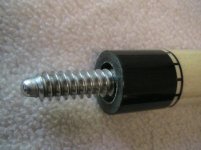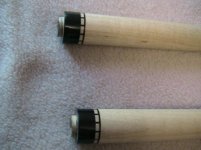It can cause your ferrule to mushroom over time especially if you follow through to the table - that's about it.
You are using an out of date browser. It may not display this or other websites correctly.
You should upgrade or use an alternative browser.
You should upgrade or use an alternative browser.
Breaking with playing cue... bad for cue?
- Thread starter slyfox
- Start date
glengarets
Registered
If your player has a hard tip you can break with it. Or you can use a house cue if you don't want to take the chance. Or just borrow one of your buddies cues and use that as your breaker :grin:
O
You mean to say your playing cue has screw on tips?
I break with my playing cue. Sometimes I switch out the tip for a breaktip and then put the playing tip back on.It is 10 seconds to change.
You mean to say your playing cue has screw on tips?
My current break cue is just a McD butt with a cheap "Panther" shaft on it. Basically it's a straight taper shaft with a hard time on it. I do it because I feel more confident in my break with the straight taper on it and that it has a nickle radius on it while my playing cue has a dime radius. It's probably all mental, but I feel I'm much better with my center ball hit on my break with the nickle radius. Plus, it protects the dime radius on my playing cue. I've broken with my player before when I was too lazy to walk across the room to get my break cue before to no ill effects, I just prefer to use my breaker.
I won't break with my playing cue. I won't drive with my putter either. Technology has advanced in the last 30 years or so. My break cue has a g-10 tip with a concave center spot, thicker diameter shaft with a conical taper, is rear weighted, and breaks racks just tons better than my playing cue. To each his own.

I won't break with my playing cue. I won't drive with my putter either. Technology has advanced in the last 30 years or so. My break cue has a g-10 tip with a concave center spot, thicker diameter shaft with a conical taper, is rear weighted, and breaks racks just tons better than my playing cue. To each his own.

Is that tip allowed in a TX?
Its mostly about the tip. Breaking is a hard impact that can flat-spot your playing tip. This, in turn, will have an affect on your next shot. Layered tips aren't as bad, but the regular, compressed tips get harder throughout the life of the tip. The harder you hit, the less the life span.
To each his own. A breaking cue does not have to be a "breaking cue." It can be any cue, with or without a special tip.
Collars cracking are of no real concern if the cue is constructed correctly.
I agree with the expert above...:grin:
O
You mean to say your playing cue has screw on tips?
Like in the avatar. They are Taper seating and play the same as glued tips with the advantage of being able to change them.It is not accurate to call them a screw on tip.I need to update the avatar as the new ones now have a special C spanner to undo the tip holder.
I am also using the system to alter the tip weight on my cues, as the latest of my cueshafts has a very long bridge bridgepoint.
When allowed I use a phenolic break tip,otherwise use a tip other than the playing tip.
I am not one to really smash the rack, but have noticed that when I break there is a definite flat on the tip.
Is that tip allowed in a TX?
As far as I know, its allowed everywhere but the BCA Nationals.
Great discussion.
Ditto.... Gotta agree with Rat Cues. Most cue-makers agree that a well built cue should never have a problem with breaking if it is built correctly and well... that's my consensus atleast.
I have noticed I go through my tip faster though. Sometimes, I just like the ability to break and not have to switch cues and/or worry about having one of my cues in the corner where joe schmo could knock it over.
Thanks all. Love the opinions and the facts. :thumbup:
3/8x10 piloted.... here's a pic of the request earlier.... talk about feel... and good construction. I don't ever feel afraid to break with it.
Ditto.... Gotta agree with Rat Cues. Most cue-makers agree that a well built cue should never have a problem with breaking if it is built correctly and well... that's my consensus atleast.
I have noticed I go through my tip faster though. Sometimes, I just like the ability to break and not have to switch cues and/or worry about having one of my cues in the corner where joe schmo could knock it over.
Thanks all. Love the opinions and the facts. :thumbup:
3/8x10 piloted.... here's a pic of the request earlier.... talk about feel... and good construction. I don't ever feel afraid to break with it.
Attachments
if my player can't break then it can't play
I subscribe to that theory as well. I do have a matched set (Player and Jump/Break) and often find myself going the other way: Break with the Jump/Break, then finish the inning with it!
So, the ancillary to the original theory would be: if my breaker can't play then it can't break!
I'm sure this debate has been had and is still continuing....
I have heard it is bad to break with your shooting cue/main player.
I have also heard it is absolutely not detrimental to the cue.
Understanding that some breaks are more powerful than others and that some go down into the table, I would assume some breaks can strain the cue.
Do certain joint styles have different affects? Obviously a 5/16x18 flatfaced joint is going to incur more strain and detriment than a radial and a 3/8x10.... or that's my assumption.
I break with my shooting cue.... 3/8x10 piloted joint.
Just thought some more knowledgeable members would know more than myself...
Thanks everyone!!!
What makes a 3/8-10 stronger than a 5/16-18 when tightened to the same torque?
Mace and Gilbert jump break's are also great playing cues and I have used them to break and play with lots of time's and never had a problem.
DolphinNoSharks
New member
Before I switched to a layered tip, I always used one cue for both but now my SS is way too soft to break with. Although, when I'm lazy, I still bring only my shooting cue to 9 ball as I don't need a hard break in 9 ball.
Since I bought my Joe Porper Little Shaver about a month ago, I've removed mushrooms off of 3 teammates cues. All three were from teammates that only used one cue for both shooting & breaking.
BTW, the Joe Porper Little Shaver is a really nice tool for the price. So far, I've done 3 mushroom trimmings & 3 trims from new tips I've installed and I haven't cut the ferrule once. I haven't used it on a layered tip yet so I'm not sure how it would perform on a really thick tip.
Since I bought my Joe Porper Little Shaver about a month ago, I've removed mushrooms off of 3 teammates cues. All three were from teammates that only used one cue for both shooting & breaking.
BTW, the Joe Porper Little Shaver is a really nice tool for the price. So far, I've done 3 mushroom trimmings & 3 trims from new tips I've installed and I haven't cut the ferrule once. I haven't used it on a layered tip yet so I'm not sure how it would perform on a really thick tip.
What makes a 3/8-10 stronger than a 5/16-18 when tightened to the same torque?
Well. I'm not entirely certain I would say it's significantly stronger. I would make the argument though, that a 3x8/10 should be a stronger constructed joint. From what I have seen from cues atleast and my limited experience. I do have to say though, a good friend of mine has been using a Jerry -R- cue for a long long time (5/16x18 piloted) and I don't think that cue will ever have issues.
IHMO. I may be wrong. Just my personal experience.
Thanks for the discussion everyone.

